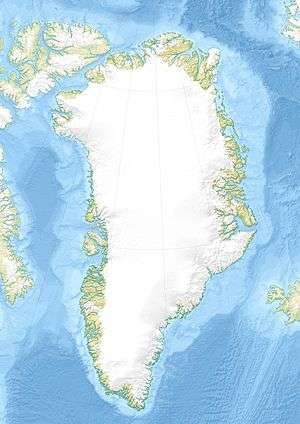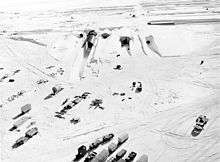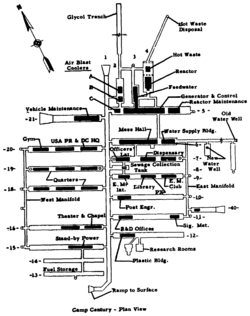Project Iceworm
Coordinates: 77°10′N 61°08′W / 77.167°N 61.133°W

Project Iceworm was the code name for a top-secret United States Army program during the Cold War to build a network of mobile nuclear missile launch sites under the Greenland ice sheet. The ultimate objective of placing medium-range missiles under the ice — close enough to strike targets within the Soviet Union — was kept secret from the Danish government. To study the feasibility of working under the ice, a highly publicized "cover" project, known as Camp Century, was launched in 1960.[1] Unsteady ice conditions within the ice sheet caused the project to be canceled in 1966.
Political background


Details of the missile base project were secret for decades, but first came to light in January 1995 during an enquiry by the Danish Foreign Policy Institute (DUPI) into the history of the use and storage of nuclear weapons in Greenland. The enquiry was ordered by the Danish parliament following the release of previously classified information about the 1968 Thule Air Base B-52 crash that contradicted previous assertions by the Danish government.[2]
Description
To test the feasibility of construction techniques a project site called "Camp Century" was started by the United States military, located at an elevation of 6,600 feet (2,000 m) in northwestern Greenland, 150 miles (240 km) from the American Thule Air Base.[3][4] The radar and air base at Thule had already been in active use since 1951.
Camp Century was described at the time as a demonstration of affordable ice-cap military outposts. The secret Project Iceworm was to be a system of tunnels 4,000 kilometres (2,500 mi) in length, used to deploy up to 600 nuclear missiles, that would be able to reach the Soviet Union in case of nuclear war. The missile locations would be under the cover of Greenland's ice sheet and were supposed to be periodically changed. While Project Iceworm was secret, plans for Camp Century were discussed with and approved by Denmark, and the facility, including its nuclear power plant, was profiled in The Saturday Evening Post magazine in 1960.
The "official purpose" of Camp Century, as explained by the United States Department of Defense to Danish government officials in 1960, was to test various construction techniques under Arctic conditions, explore practical problems with a semi-mobile nuclear reactor, as well as supporting scientific experiments on the icecap.[5] A total of 21 trenches were cut and covered with arched roofs within which prefabricated buildings were erected.[6] With a total length of 3,000 metres (1.9 mi), these tunnels also contained a hospital, a shop, a theater and a church. The total number of inhabitants was around 200. From 1960 until 1963 the electricity supply was provided by means of the world's first mobile/portable nuclear reactor, designated the PM-2A and designed by Alco for the U.S. Army.[7] Water was supplied by melting glaciers and tested to determine whether germs such as the plague were present.
Within three years after it was excavated, ice core samples taken by geologists working at Camp Century demonstrated that the glacier was moving much faster than anticipated and would destroy the tunnels and planned launch stations in about two years. The facility was evacuated in 1965, and the nuclear generator removed. Project Iceworm was canceled, and Camp Century closed in 1966.
The project generated valuable scientific information and provided scientists with some of the first ice cores, still being used by climatologists today.[8]
Size of proposed missile complex
According to the documents published by Denmark in 1997, the U.S. Army's "Iceworm" missile network was outlined in a 1960 Army report titled "Strategic Value of the Greenland Icecap". If fully implemented, the project would cover an area of 52,000 square miles (130,000 km2), roughly three times the size of Denmark. The launch complex floors would be 28 feet (8.5 m) below the surface, with the missile launchers even deeper, and clusters of missile launch centers would be spaced 4 miles (6.4 km) apart. New tunnels were to be dug every year, so that after five years there would be thousands of firing positions, among which the several hundred missiles could be rotated. The Army intended to deploy a shortened, two-stage version of the U.S. Air Force's Minuteman missile, a variant the Army proposed calling the Iceman.[9]
Sheet ice elasticity
Although the Greenland icecap appears, on its surface, to be hard and immobile, snow and ice are viscoelastic materials, which slowly deform over time, depending on temperature and density. Despite its seeming stability, the icecap is, in fact, in constant, slow movement, spreading outward from the center. This spreading movement, over the course of a year, causes tunnels and trenches to narrow, as their walls deform and bulge, eventually leading to a collapse of the ceiling. By mid-1962 the ceiling of the reactor room within Camp Century had dropped and had to be lifted 5 feet (1.5 m). During a planned reactor shutdown for maintenance in late July 1963, the Army decided to operate Camp Century as a summer-only camp and did not reactivate the PM-2A reactor. The camp resumed operations in 1964 using its standby diesel power plant, the portable reactor was removed that summer, and the camp was abandoned altogether in 1966.[10]
Climate change
When the camp was decommissioned in 1967, its infrastructure and waste were abandoned under the assumption they would be entombed forever by perpetual snowfall. A 2016 study found that the portion of the ice sheet covering Camp Century will start to melt by the end of the century, if current trends continue.[11] When the ice melts, the camp’s infrastructure, as well as any remaining biological, chemical and radioactive waste, will re-enter the environment and potentially disrupt nearby ecosystems.[12][13][14]
See also
References
- ↑ Clark, Elmer F. (October 1965). Camp Century: Evolution of Concept and History of Design, Construction and Performance (PDF). Technical Report, United States Army Materiel Command Cold Regions Research and Engineering Laboratory (Report).
- ↑ Amstrup, Niels (1997-01-17). "Grønland under den kolde krig. Dansk og Amerikansk sikkerhedspolitik 1945–1968" [Greenland during the Cold War. Danish and American security policy 1945–1968]. Politica (in Danish). Copenhagen: Danish Institute of International Affairs. 29 (2): 215. Archived from the original on 2011-07-19. Retrieved 2009-04-26.
- ↑ Feldman, Cassi (31 January 2016). "Cronkite visits "city under the ice" in 1961". 60 minutes overtime. CBSnews. Retrieved 2016-08-10.
- ↑ US Army (1963). "Camp Century, Greenland, Project Iceworm: "City Under the Ice" R&D Progress Report 6". Youtube. US Army.
- ↑ Petersen 2008, pp. 75–98; official purpose and size and length of Camp Century tunnels given on p.78.
- ↑ United States Army (1961). M.F.5 9314 (Camp Century (1 of 4)) (Film) – via YouTube.
- ↑ The U.S. Army's Top Secret Arctic City Under the Ice! "Camp Century" Restored Classified Film
- ↑ Dansgaard, Willi (2005). Frozen Annals, Greenland Ice Cap Research (pdf). Icelandic Climate. Copenhagen: Niels Bohr Institute. pp. 54–63. ISBN 87-990078-0-0.
- ↑ Petersen 2008, p. 80
- ↑ Petersen 2008, p. 79
- ↑ Colgan, William; Machguth, Horst; MacFerrin, Mike; Colgan, Jeff D.; van As, Dirk; MacGregor, Joseph A. (2016). "The abandoned ice sheet base at Camp Century, Greenland, in a warming climate". Geophysical Research Letters: 2016GL069688. doi:10.1002/2016GL069688. ISSN 1944-8007.
- ↑ "Melting ice sheet could release frozen Cold War-era waste". August 4, 2016.
- ↑ Christopher, Joyce (August 5, 2016). "Melting Ice In Greenland Could Expose Serious Pollutants From Buried Army Base". National Public Radio. Retrieved 2016-08-08.
- ↑ Henley, Jon (27 September 2016). "Greenland's receding icecap to expose top-secret US nuclear project". The Guardian. London. Retrieved 27 September 2016.
Bibliography
- "Aukstajā karā uzvarēja ledus" [Ice won the Cold War]. Ilustrētā zinātne [Science Illustrated] (in Latvian). Riga, Latvia: Bonnier Publications International A/S (34): 85. September 2008. ISSN 1691-256X.
- Grant, Shelagh (2010). Polar Imperative: A History of Arctic Sovereignty in North America. Douglas & McIntyre. ISBN 978-1-55365-418-6.
- Petersen, Nikolaj (March 2008). "The Iceman That Never Came: 'Project Iceworm', the search for a NATO deterrent, and Denmark, 1960–1962". Scandinavian Journal of History. 33 (1).
- Suid, Lawrence H. (1990). The Army's Nuclear Power Program: Evolution of a Support Agency. Greenwood Publishing Group. ISBN 0-313-27226-3. Camp Century and its PM-2A reactor covered by Suid in "Chapter 5: The Nuclear Power in Full Bloom", pp. 57–80.
- Weiss, Erik D. (Fall 2001). "Cold War Under the Ice: The Army's Bid for a Long-Range Nuclear Role, 1959–1963". Journal of Cold War Studies. 3 (3): 31–58. doi:10.1162/152039701750419501. (subscription required (help)).
- Schrader, Christopher (2016-08-10). "Sauerei unter dem Eis. Ex-Militärbasis könnte Umweltkatastrophe auslösen.". Süddeutsche Zeitung. 2016 (184): 16. (online)
External links
| Wikimedia Commons has media related to Camp Century. |
- The Big Picture: Camp Century
- Camp Century, Greenland, Frank J. Leskovitz (including good pictures and diagrams)
- U.S. Military Buildup of Thule, Woods Hole Oceanographic Institution
- Camp Century, thuleab.dk
- Atomic Insights Nov 1995 Comments on army film.
- Glaciological Studies in the Vicinity of Camp Century, Greenland
- Documentary film on YouTube